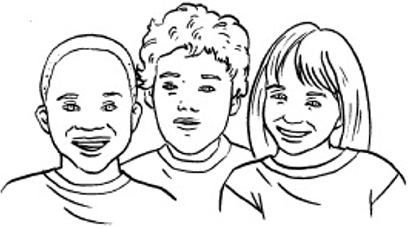| << Chapter < Page | Chapter >> Page > |
more/less/the same number of
First is Liz, second is ___________________________________________________
third is ____________________________, fourth is __________________________,
fifth is ___________________________, sixth is ____________________________,
seventh is ___________________________, eighth is ________________________,
ninth is ___________________________ and last is __________________________

Sally comes after ______________________________________________________
Mike comes before _____________________________________________________
Tom is between _________________________ and __________________________
1st 2nd 3rd 4th _______ _______ _______ _______ _______ _______
| LO 1.1 | LO 1.4 |
Numbers also have names.
1 _______________________________________________________________
2 _______________________________________________________________
3 _______________________________________________________________
4 _______________________________________________________________
5 _______________________________________________________________
6 _______________________________________________________________
7 _______________________________________________________________
8 _______________________________________________________________
9 _______________________________________________________________
10 _______________________________________________________________
| 0 | 1 | 3 | 7 | 10 |
| 10 | 9 |
| LO 1.3 | LO 1.10 |
All about my friends.

| The length of my friends' hair | |||||||||||
| Long hair | |||||||||||
| Short hair | |||||||||||
| friends | 1 | 2 | 3 | 4 | 5 | 6 | 7 | 8 | 9 | 10 |

Write:
| LO 5.1 | LO 5.2 | LO 5.4 | LO 5.5 |




Guess ________________________________
Count ________________________________
| LO 1.2 |
Learning Outcome 1: The learner will be able to recognise, describe and represent numbers and their The learner will be able to recognise, describe and represent numbers and their relationships, and to count, estimate, calculate and check with competence and confidence in solving problems.
Assessment Standard 1.1: We know this when the learner counts to at least 100 everyday objects reliably;
Assessment Standard 1.2: We know this when the learner counts forwards and backwards in:
1.2.1 ones from any number between 0 and 200;
1.2.2 tens from any multiple of 10 between 0 and 200;
1.2.3 fives from any multiple of 5 between 0 and 200;
1.2.4 twos from any multiple of 2 between 0 and 200;
Assessment Standard 1.3: We know this when the learner knows and reads number symbols from 1 to at least 200 and writes number names from 1 to at least 100;
Assessment Standard 1.4: We know this when the learner orders, describes and compares the following numbers:
1.4.1 whole numbers to at least 2-digit numbers;
1.4.2 common fractions including halves and quarters;
Assessment Standard 1.10: We know this when the learner uses the following techniques:
1.10.1 building up and breaking down numbers;
1.10.2 doubling and halving;
1.10.3 using concrete apparatus (e.g. counters);
1.10.4 number-lines;
Learning Outcome 4: The learner will be able to use appropriate measuring units, instruments and formulae in a variety of contexts.
Assessment Standard 4.4: We know this when the learner sequences events according to days, weeks, months and years;
Learning Outcome 5: The learner will be able to collect, summarise, display and critically analyse data in order to draw conclusions and make predictions, and to interpret and determine chance variation.
Assessment Standard 5.1: We know this when the learner collects data (alone and/or as a member of a group or team) in the classroom and school environment to answer questions posed by the teacher (e.g. ‘how many learners are there in each classroom?’);
Assessment Standard 5.2: We know this when the learner sorts physical objects to one attribute chosen by the teacher;
Assessment Standard 5.4: We know this when the learner draws pictures and constructs pictographs that have a 1-1 correspondence between own data and representations;
Assessment Standard 5.5: We know this when the learner describes own or a peer’s collection of objects, explains how it was sorted, and answers questions about it.

Notification Switch
Would you like to follow the 'Mathematics grade 2' conversation and receive update notifications?